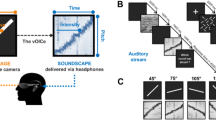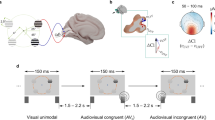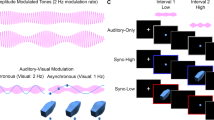Abstract
Sounds modulate visual perception. Blind humans show altered brain activity in early visual cortex. However, it is still unclear whether crossmodal activity in visual cortex results from unspecific top-down feedback, a lack of visual input, or genuinely reflects crossmodal interactions at early sensory levels. We examined how sounds affect visual perceptual learning in sighted adults. Visual motion discrimination was tested prior to and following eight sessions in which observers were exposed to irrelevant moving dots while detecting sounds. After training, visual discrimination improved more strongly for motion directions that were paired with a relevant sound during training than for other directions. Crossmodal learning was limited to visual field locations that overlapped with the sound source and was little affected by attention. The specificity and automatic nature of these learning effects suggest that sounds automatically guide visual plasticity at a relatively early level of processing.




Similar content being viewed by others
References
Ahissar M, Hochstein S (1993) Attentional control of early perceptual learning. Proc Natl Acad Sci USA 90:5718–5722
Ahissar M, Hochstein S (2004) The reverse hierarchy theory of visual perceptual learning. Trends Cogn Sci 8:457–464
Andersen RA, Snyder LH, Bradley DC, Xong J (1997) Multimodal representation of space in the posterior cortex and its use in planning movements. Annu Rev Neurosci 20:303–330
Beer AL, Röder B (2005) Attending to visual or auditory motion affects perception within and across modalities: an event-related potential study. Eur J Neurosci 21:1116–1130
Brainard DH (1997) The psychophysics toolbox. Spat Vis 10:433–436
Büchel C, Price C, Frackowiak RSJ, Friston K (1998) Different activation patterns in the visual cortex of late and congenitally blind subjects. Brain 121:409–419
Crist RE, Kapadia MK, Westheimer G, Gilbert CD (1997) Perceptual learning of spatial localization: specificity for orientation, position, and context. J Neurophysiol 78:2889–2894
Driver J, Noesselt T (2008) Multisensory interplay reveals crossmodal influences on ‘sensory-specific’ brain regions, neural responses, and judgments. Neuron 57:11–23
Dumoulin SO, Wandell BA (2008) Population receptive field estimates in human visual cortex. Neuroimage 39:647–660
Eimer M (2001) Crossmodal links in spatial attention between vision, audition, and touch: evidence from event-related brain potentials. Neuropsychologia 39:1292–1303
Felleman DJ, Kaas JH (1984) Receptive-field properties of neurons in middle temporal visual area (MT) of owl monkeys. J Neurophysiol 52:488–513
Fiorentini A, Berardi N (1980) Perceptual learning specific for orientation and spatial frequency. Nature 287:43–44
Gibson EJ (1963) Perceptual learning. Annu Rev Psychol 14:29–56
Gougoux F, Zatorre RJ, Lassonde M, Voss P, Lepore F (2005) A functional neuroimaging study of sound localization: visual cortex activity predicts performance in early-blind individuals. PLoS Biol 3:e27
Grantham DW (1986) Detection and discrimination of simulated motion of auditory targets in the horizontal plane. J Acoust Soc Am 79:1939–1949
Heeger DJ, Boynton GM, Demb JB, Seidemann E, Newsome WT (1999) Motion opponency in visual cortex. J Neurosci 19:7162–7174
Jääskeläinen IP, Ahveninen J, Bonmassar G, Dale AM, Ilmoniemi RJ, Levänen S, Lin F-H, May P, Melcher J, Stufflebeam S, Tiitinen H, Belliveau JW (2004) Human posterior auditory cortex gates novel sounds to consciousness. Proc Natl Acad Sci USA 101:6809–6814
Karni A, Sagi D (1991) Where practice makes perfect in texture discrimination: evidence for primary visual cortex plasticity. Proc Natl Acad Sci USA 88:4966–4970
Katz LC, Shatz CJ (1996) Synaptic activity and the construction of cortical circuits. Science 274:1133–1138
Li W, Piech V, Gilbert CD (2004) Perceptual learning and top-down influences in primary visual cortex. Nat Neurosci 7:651–657
Loftus GR, Masson MEJ (1994) Using confidence intervals in within-subject designs. Psychon Bull Rev 1:476–490
Macaluso E, Frith CD, Driver J (2000) Modulation of human visual cortex by crossmodal spatial attention. Science 289:1206–1208
Mazza V, Turatto M, Rossi M, Umiltà C (2007) How automatic are audiovisual links in exogenous spatial attention? Neuropsychologia 45:514–522
McDonald JJ, Teder-Sälejärvi WA, Hillyard SA (2000) Involuntary orienting to sound improves visual perception. Nature 407:906–908
McDonald JJ, Teder-Sälejärvi WA, Di Russo F, Hillyard SA (2003) Neural substrates of perceptual enhancement by cross-modal spatial attention. J Cogn Neurosci 15:10–19
McDonald JJ, Teder-Sälejärvi WA, Di Russo F, Hillyard SA (2005) Neural basis of auditory-induced shifts in visual time-order perception. Nat Neurosci 8:1197–1202
Meredith MA, Stein BE (1986) Spatial factors determine the activity of multisensory neurons in cat superior colliculus. Brain Res 365:350–354
Middlebrooks JC, Green DM (1991) Sound localization by human listeners. Annu Rev Psychol 42:135–159
Poirier C, Collignon O, Scheiber C, Renier L, Vanlierde A, Tranduy D, Veraart C, De Volder AG (2006) Auditory motion perception activates visual motion areas in early blind subjects. Neuroimage 31:279–285
Rinne T, Antila S, Winkler I (2001) Mismatch negativity is unaffected by top-down predictive information. Neuroreport 12:2209–2213
Röder B, Stock O, Bien S, Neville H, Rösler F (2002) Speech processing activates visual cortex in congenitally blind humans. Eur J Neurosci 16:930–936
Rozas C, Frank H, Heynen AJ, Morales B, Bear MF, Kirkwood A (2001) Developmental inhibitory gate controls the relay of activity to the superficial layers of the visual cortex. J Neurosci 21:6791–6801
Schoups AA, Vogels R, Orban GA (1995) Human perceptual learning in identifying the oblique orientation: retinotopy, orientation specificity and monocularity. J Physiol 483:797–810
Schoups A, Vogels R, Qian N, Orban G (2001) Practising orientation identification improves orientation coding in V1 neurons. Nature 412:549–553
Schwartz S, Maquet P, Frith C (2002) Neural correlates of perceptual learning: a functional MRI study of visual texture discrimination. Proc Natl Acad Sci USA 99:17137–17142
Seitz A, Watanabe T (2003) Is subliminal learning really passive? Nature 422:36
Seitz A, Kim R, Shams L (2006) Sound facilitates visual learning. Curr Biol 16:1422–1427
Smith AT, Singh KD, Williams AL, Greenlee MW (2001) Estimating receptive field size from fMRI data in human striate and extrastriate visual cortex. Cereb Cortex 11:1182–1190
Sowden PT, Rose D, Davies IRL (2002) Perceptual learning of luminance contrast detection: specific for spatial frequency and retinal location but not orientation. Vis Res 42:1249–1258
Spence C, Driver J (1996) Audiovisual links in endogenous covert spatial attention. J Exp Psychol Hum Percept Perform 22:1005–1030
Spence C, Driver J (1997) Audiovisual links in exogenous covert spatial orienting. Percept Psychophys 59:1–22
Strybel TZ, Fujimoto K (2000) Minimum audible angles in the horizontal and vertical planes: effects of stimulus onset asynchrony and burst duration. J Acoust Soc Am 108:3092–3095
Swets JA (1973) The relative operating characteristic in psychology. Science 182:990–1000
Teder-Sälejärvi WA, Münte TF, Sperlich F-J, Hillyard SA (1999) Intra-modal and cross-modal spatial attention to auditory and visual stimuli. An event-related brain potential study. Cogn Brain Res 8:327–343
Tsushima Y, Sasaki Y, Watanabe T (2006) Greater disruption due to failure of inhibitory control on an ambiguous distractor. Science 314:1786–1788
Watanabe T, Náñez JE, Sasaki Y (2001) Perceptual learning without perception. Nature 413:844–848
Watanabe T, Náñez JE, Koyama S, Mukai I, Liederman J, Sasaki Y (2002) Greater plasticity in lower-level than higher-level visual motion processing in a passive perceptual learning task. Nat Neurosci 5:1003–1009
Weeks R, Horwitz B, Aziz-Sultan A, Tian B, Wessinger CM, Cohen LG, Hallett M, Rauschecker JP (2000) A positron emission tomographic study of auditory localization in the congenitally blind. J Neurosci 20:2664–2672
Xiao DK, Raiguel S, Marcar V, Orban GA (1997) The spatial distribution of the antagonistic surround of MT/V5 neurons. Cereb Cortex 7:662–677
Acknowledgments
This work was supported by the National Science Foundation (BCS-0549036), the National Institute of Health (R01 EY015980-01, R21 EY02342-01) and the Human Frontier Foundation (RGP18/2004).
Author information
Authors and Affiliations
Corresponding author
Rights and permissions
About this article
Cite this article
Beer, A.L., Watanabe, T. Specificity of auditory-guided visual perceptual learning suggests crossmodal plasticity in early visual cortex. Exp Brain Res 198, 353–361 (2009). https://doi.org/10.1007/s00221-009-1769-6
Received:
Accepted:
Published:
Issue Date:
DOI: https://doi.org/10.1007/s00221-009-1769-6




